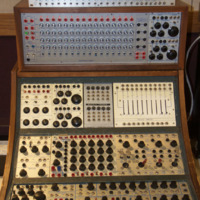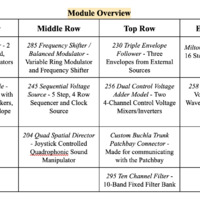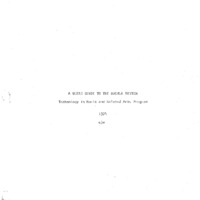Buchla 200
Item
Model
Buchla 200
Make
Buchla
Type
Analog Synth
Modular Synth
Description
Name: Buchla 200 Synthesizer
Made: Early 1970’s
Type: Analog Modular
Oscillators: 4
Filters: 5
Sequencers: 8
VCAs: 3
Envelopes: 7
Made: Early 1970’s
Type: Analog Modular
Oscillators: 4
Filters: 5
Sequencers: 8
VCAs: 3
Envelopes: 7
Overview:
The Buchla Series 200 Modular Synthesizer (originally dubbed the “Electronic Music Box”) was created by Californian inventor Don Buchla in 1970. The 200 Series was a collection of 46 discrete modules--each sold separately, but typically assembled into a single unit. This sales model allowed patrons to compile their own custom sound making machines. This series of modules followed the 100 series made from 1963 to 1969, which is known as one of the most historically significant inventions in electronic music. Alongside Robert Moog on the east coast, Don Buchla worked on the west coast to create a new type of electronic instrument. These would take the form of the first modular synthesizers. Buchla’s goal in designing instruments was to facilitate the performance of electronic music and to allow artists to create entirely new sonic possibilities. While the Buchla was not as commercially successful as the Moog synthesizer, it is still of equal importance to the history of electronic music. Following the original 100 series, Buchla created the 200 series to expand on his original designs for his growing clientele.
TIMARA’s Buchla 200 System is a collection of 9 original Buchla 200 Series modules, and a Milton Plan B Sequencer. The Buchla modules are all original early 200 series modules from the early 70’s (indicated by the black knobs on the system, which were replaced by blue and silver knobs later in the decade). These modules were only made until 1978;approximately one- to two-hundred instances of each module were manufactured. These modules are therefore incredibly rare and valuable; a full system is now valued at around $50,000. The Milton sequencer was donated by a TIMARA alumnus in 2015. It is a rare module, made in the early 2000’s specifically for Serge Modular systems (another early synthesizer with a similar format to the Buchla).
The Buchla works on the concept of modularity: functions are performed by separate modules and it is up to the user to patch them together. The Buchla uses both eighth-inch and banana jacks/cables for patching. Eighth-inch connections are used for routing audio signals, while banana jacks are used for control voltages. There are actually two kinds of banana jacks on the Buchla: red and black. The red jacks send and receive trigger pulses-- a discrete voltage of either 0 or 15 volts. Certain modules use this sudden electrical pulse to trigger events, such as advancing a sequencer or triggering an envelope generator. Black jacks send and receive control voltages between 0 and 15 volts, inclusive; these control voltages can be used to control parameters on other modules.
Another helpful tool for patching is multiples. Multiples are typically indicated on modules by a small line drawn between the outputs (the only modules where this isn’t the case are the audio outputs of the Oscillator and Quad Spatial Director, and the voltage outputs of the 245 Sequencer). These enable you to route the same signal to multiple destinations.
As you patch, pay attention to the LEDs. The LED lights featured on some modules are very helpful for visualizing what is happening; they are particularly useful as a tool for understanding sequencers, random voltages and envelopes.
The Buchla Series 200 Modular Synthesizer (originally dubbed the “Electronic Music Box”) was created by Californian inventor Don Buchla in 1970. The 200 Series was a collection of 46 discrete modules--each sold separately, but typically assembled into a single unit. This sales model allowed patrons to compile their own custom sound making machines. This series of modules followed the 100 series made from 1963 to 1969, which is known as one of the most historically significant inventions in electronic music. Alongside Robert Moog on the east coast, Don Buchla worked on the west coast to create a new type of electronic instrument. These would take the form of the first modular synthesizers. Buchla’s goal in designing instruments was to facilitate the performance of electronic music and to allow artists to create entirely new sonic possibilities. While the Buchla was not as commercially successful as the Moog synthesizer, it is still of equal importance to the history of electronic music. Following the original 100 series, Buchla created the 200 series to expand on his original designs for his growing clientele.
TIMARA’s Buchla 200 System is a collection of 9 original Buchla 200 Series modules, and a Milton Plan B Sequencer. The Buchla modules are all original early 200 series modules from the early 70’s (indicated by the black knobs on the system, which were replaced by blue and silver knobs later in the decade). These modules were only made until 1978;approximately one- to two-hundred instances of each module were manufactured. These modules are therefore incredibly rare and valuable; a full system is now valued at around $50,000. The Milton sequencer was donated by a TIMARA alumnus in 2015. It is a rare module, made in the early 2000’s specifically for Serge Modular systems (another early synthesizer with a similar format to the Buchla).
The Buchla works on the concept of modularity: functions are performed by separate modules and it is up to the user to patch them together. The Buchla uses both eighth-inch and banana jacks/cables for patching. Eighth-inch connections are used for routing audio signals, while banana jacks are used for control voltages. There are actually two kinds of banana jacks on the Buchla: red and black. The red jacks send and receive trigger pulses-- a discrete voltage of either 0 or 15 volts. Certain modules use this sudden electrical pulse to trigger events, such as advancing a sequencer or triggering an envelope generator. Black jacks send and receive control voltages between 0 and 15 volts, inclusive; these control voltages can be used to control parameters on other modules.
Another helpful tool for patching is multiples. Multiples are typically indicated on modules by a small line drawn between the outputs (the only modules where this isn’t the case are the audio outputs of the Oscillator and Quad Spatial Director, and the voltage outputs of the 245 Sequencer). These enable you to route the same signal to multiple destinations.
As you patch, pay attention to the LEDs. The LED lights featured on some modules are very helpful for visualizing what is happening; they are particularly useful as a tool for understanding sequencers, random voltages and envelopes.
Access
Those with permission to use Studio 4
Location
Studio 4: Analog Synth Studio



